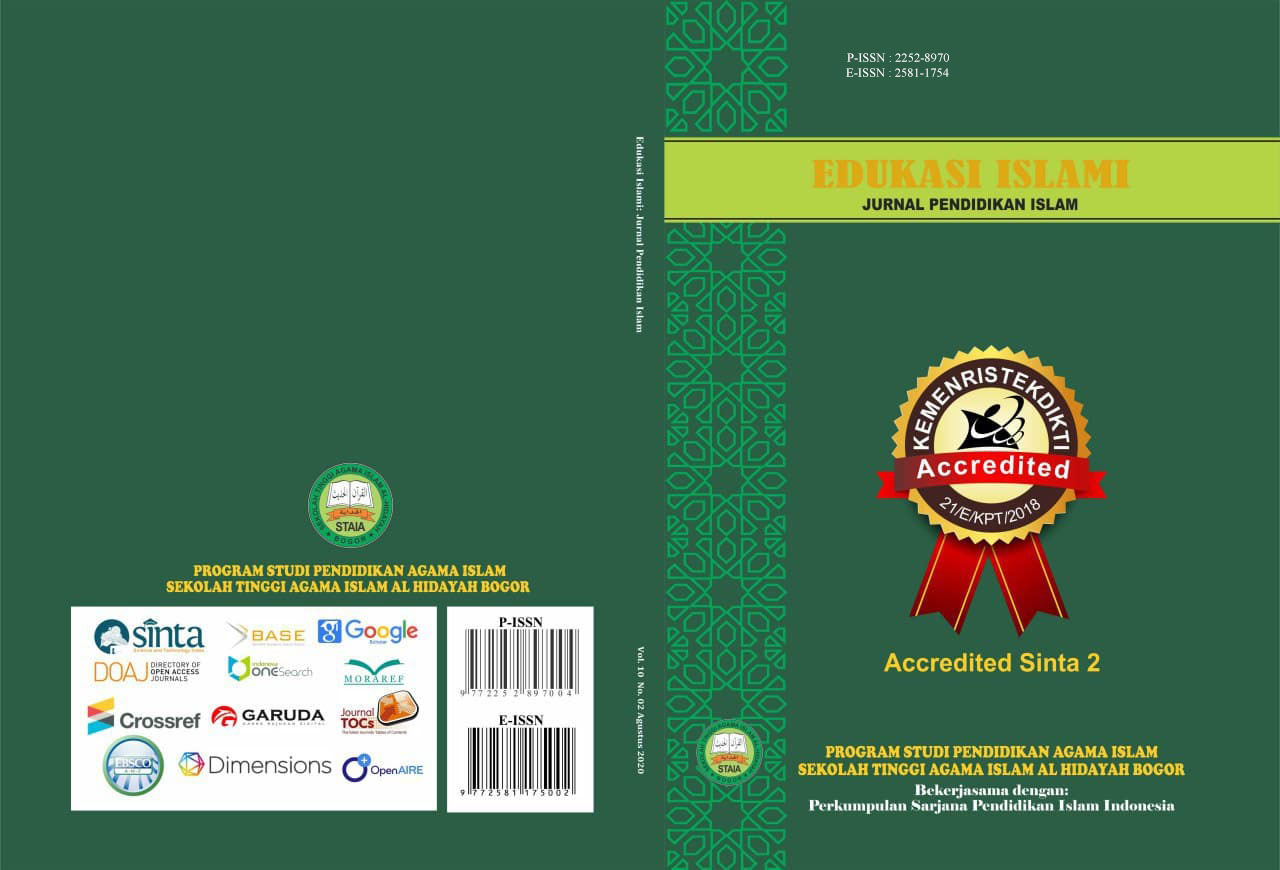Quality of Education in Islamic Schools: A Bibliometric Review Study
Keywords:
Bibliometric Analysis, Density, Network, Quality of Islamic Education VOS viewerAbstract
References
Aguinis, H., Dalton, D. R., Bosco, F. A., Pierce, C. A., & Dalton, C. M. (2011). Meta-Analytic Choices and Judgment Calls: Implications for Theory Building and Testing, Obtained Effect Sizes, and Scholarly Impact. Journal of Management, 37(1), 5–38. https://doi.org/10.1177/0149206310377113
Al-Muslim, M., & Arifin, Z. (2015). The usability of SEEQ in quality evaluation of arabic secondary education in Malaysia.International Education Studies, 8(3), 202–211. https://doi.org/10.5539/ies.v8n3p202
Ali, H. M., & Musah, M. B. (2012). Investigation of Malaysian higher education quality culture and workforce performance. Quality Assurance in Education, 20(3), 289–309. https://doi.org/10.1108/09684881211240330
Aria, M., & Cuccurullo, C. (2017). bibliometrix: An R-tool for comprehensive science mapping analysis. Journal of Informetrics, 11(4), 959–975. https://doi.org/10.1016/j.joi.2017.08.007
Azra, A. (2023). Islamic Studies in Indonesia, from IAIN to UIN. In Islam, Education and Radicalism in Indonesia (Vol. 12, Issue 1, pp. 196–207). Routledge. https://doi.org/10.4324/9781003269229-12
Baporikar, N. (2021). Stakeholder Approach for Quality Higher Education. In Research Anthology on Preparing School Administrators to Lead Quality Education Programs (Vol. 89, Issue 3, pp. 1664–1690). IGI Global. https://doi.org/10.4018/978-1- 7998-3438-0.ch075
Bogue, E. G. (1993). On Q: Causing Quality in Higher Education. The Journal of Higher Education, 64(5), 610–612. https://doi.org/10.1080/00221546.1993.11778 456
Brika, S. K. M., Algamdi, A., Chergui, K., & Musa, A. A. (2021). Quality of Higher Education : A Bibliometric Review Study. 6(May), 1–15. https://doi.org/10.3389/feduc.2021.666087
Brookes, B. C. (1985). “Sources of information on specific subjects” by S.C. Bradford. Journal of Information Science, 10(4), 173–175. https://doi.org/10.1177/016555158501000406
de Matos Pedro, E., Leitão, J., & Alves, H. (2020). Bridging intellectual capital, sustainable development and quality of life in higher education institutions. Sustainability (Switzerland), 12(2). https://doi.org/10.3390/su12020479
DiDomenico, E., & Bonnici, J. (1996). Assessing service quality within the educational environment. Education, 116, 353+. https://link.gale.com/apps/doc/A18434919/A ONE?u=anon~edf0d611&sid=bookmark- AONE&xid=d555c497
Hallinger, P., & Kovačević, J. (2019). A Bibliometric Review of Research on Educational Administration: Science Mapping the Literature, 1960 to 2018. Review of Educational Research, 89(3), 335–369. http://www.jstor.org/stable/45277277
Iranmanesh, M., Moghavvemi, S., Zailani, S., & Hyun, S. S. (2018). The role of trust and religious commitment in Islamic medical tourism. Asia Pacific Journal of Tourism Research, 23(3), 245–259. https://doi.org/10.1080/10941665.2017.14212 40
Lotka, A. J. (1926). The frequency distribution of scientific productivity Author ( s ): Alfred J . Lotka Source : Journal of the Washington Academy of Sciences , Vol . 16 , No . 12 ( June 19 , 1926 ), Published by : Washington Academy of Sciences Stable URL : https://www.jst. Journal of the Washington Academy of Sciences, 16(12), 317–323.
Mulet-Forteza, C., Genovart-Balaguer, J., Merigó, J. M., & Mauleon-Mendez, E. (2019). Bibliometric structure of IJCHM in its 30 years. International Journal of Contemporary Hospitality Management, 31(12), 4574–4604. https://doi.org/10.1108/IJCHM-10-2018-0828
Pritchard, A. (1969). Statistical bibliography or bibliometrics. Journal of Documentation, 25, 348. https://api.semanticscholar.org/CorpusID:624 32515
Raghuram, S., Hill, N. S., Gibbs, J. L., & Maruping, L. M. (2019). Virtual Work: Bridging Research Clusters. Academy of Management Annals, 13(1), 308–341. https://doi.org/10.5465/annals.2017.0020
Raghuram, S., Tuertscher, P., & Garud, R. (2010). Research Note —Mapping the Field of Virtual Work: A Cocitation Analysis. Information Systems Research, 21(4), 983– 999. https://doi.org/10.1287/isre.1080.0227
Salas-Zapata, W. A., Ríos-Osorio, L. A., & Cardona-Arias, J. A. (2018). Knowledge, Attitudes and Practices of Sustainability: Systematic Review 1990-2016. Journal of Teacher Education for Sustainability, 20(1), 46–63. https://doi.org/10.2478/jtes-2018- 0003
van Eck, N. J., & Waltman, L. (2014). Visualizing Bibliometric Networks. In Measuring Scholarly Impact. https://doi.org/10.1007/978-3-319-10377- 8_13
Waltman, L., and Noyons, L. (2018). Bibliometrics for research management and research evaluation. universiteit Leiden. https://docslib.org/doc/9273260/bibliometrics -for-research-management-and-research- evaluation-a-brief-introduction-bibliometrics- for-research-management-and-research- evaluation
Zipf, G. K. (1949). Human behavior and the principle of least effort. In Human behavior and the principle of least effort. Addison- Wesley Press.
Zupic, I., & Čater, T. (2015). Bibliometric Methods in Management and Organization. Organizational Research Methods, 18(3), 429–472. https://doi.org/10.1177/1094428114562629
Downloads
Published
Issue
Section
Citation Check
License

This work is licensed under a Creative Commons Attribution 4.0 International License.
Authors who publish with this journal agree to the following terms:
- Authors retain copyright and grant the journal right of first publication with the work simultaneously licensed under a Creative Commons Attribution License that allows others to share the work with an acknowledgment of the work's authorship and initial publication in this journal.
- Authors are able to enter into separate, additional contractual arrangements for the non-exclusive distribution of the journal's published version of the work (e.g., post it to an institutional repository or publish it in a book), with an acknowledgment of its initial publication in this journal.
- Authors are permitted and encouraged to post their work online (e.g., in institutional repositories or on their website) prior to and during the submission process, as it can lead to productive exchanges, as well as earlier and greater citation of published work (See The Effect of Open Access).









